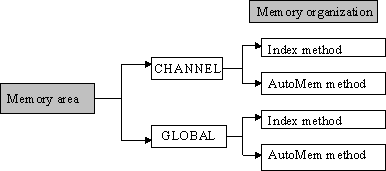INDEX: addressing the memory
Two methods are available as alternatives for addressing each variable:
1) Index method
Addressing is realised by specifying an index value (var[?].index). Each index comprises a memory of 24 bytes. If the chosen index "distance" between two successive variables is too small, memory overlapping occurs. Consequence: the memory of the following variable is overwritten. The CNC does not issue an error message because it assumes that this addressing was chosen deliberately.
2) AutoMem method
With this method, the CNC assumes memory management. The V.E. variables are entered in the memory successively in a non-overlapping fashion. When using this method, users do not need to both about correct memory assignment. An identifying feature of the AutoMem method is that declaration of the var[?].index attribute is not used in any of the variables!
The user decides according to which the methods the two memories for CHANNEL and GLOBAL are each organized.

 | + Both memories need not be organized with the same method - although both memories are declared in one V.E. list! |
Notice | |
When the index method is used, it is imperative when using the EXPORT method described here for all index values to be entered in ascending order. According to the documentation entitled "External variables", this restriction does not otherwise exist! |